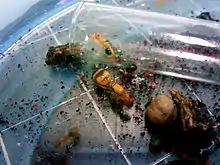Camponotus festinatus
Camponotus festinatus is a species of carpenter ant that is typically found in the Southwestern United States and northern reaches of Mexico.[1] It is most commonly found around Tucson, Arizona. It lives in the semi-dead branches of palo verde trees found in the area. Camponotus festinatus is an exclusively liquid feeder. These ants can only feed on sap from trees or the juices of a deceased animal. Like most ants, their diet is primarily sugar with some protein. Camponotus festinatus ants are not known to be aggressive except towards other ants. Soldiers will prefer to run from humans rather than be aggressive. In principle, these ants can bite with their mandibles. However, as carpenter ants like these are formicines, they have no functional sting. Instead of stinging, they can use an acidopore to spray formic acid.[2]
| Camponotus festinatus | |
|---|---|
 | |
| Camponotus festinatus worker | |
| Scientific classification | |
| Domain: | Eukaryota |
| Kingdom: | Animalia |
| Phylum: | Arthropoda |
| Class: | Insecta |
| Order: | Hymenoptera |
| Family: | Formicidae |
| Subfamily: | Formicinae |
| Genus: | Camponotus |
| Species: | C. festinatus |
| Binomial name | |
| Camponotus festinatus (Buckley, 1866) | |
| Synonyms | |
|
Formica festinata Buckley, 1866 | |
C. festinatus queens are 'claustral foundresses', in that they sequester themselves in a chamber to begin a new colony and raise the first set of worker ants without seeking out or obtaining additional food.[3]
References
- Janda, Milan; Rosas-Mejía, Madai; Corcuera, Pablo; Aguilar-Méndez, Mario Josué; Vásquez-Bolaños, Miguel; Tafoya-Alvarado, Yuliza (2019), Álvarez, Fernando; Ojeda, Margarita (eds.), "Diversity and Community Structure of Ants in the Cuatro Ciénegas Basin, Coahuila, Mexico", Animal Diversity and Biogeography of the Cuatro Ciénegas Basin, Cham: Springer International Publishing, pp. 129–145, doi:10.1007/978-3-030-11262-2_10, ISBN 978-3-030-11262-2, S2CID 164682306, retrieved 2022-10-05
- Eubanks, Micky D.; Lin, Constance; Tarone, Aaron M. (2019-03-01). "The role of ants in vertebrate carrion decomposition". Food Webs. 18: e00109. doi:10.1016/j.fooweb.2018.e00109. ISSN 2352-2496. S2CID 91779356.
- Martinez, Teresa; Wheeler, Diana E. (1994-08-01). "Storage proteins in adult ants (Camponotus festinatus): Roles in colony founding by queens and in larval rearing by workers". Journal of Insect Physiology. 40 (8): 723–729. doi:10.1016/0022-1910(94)90100-7. ISSN 0022-1910.
